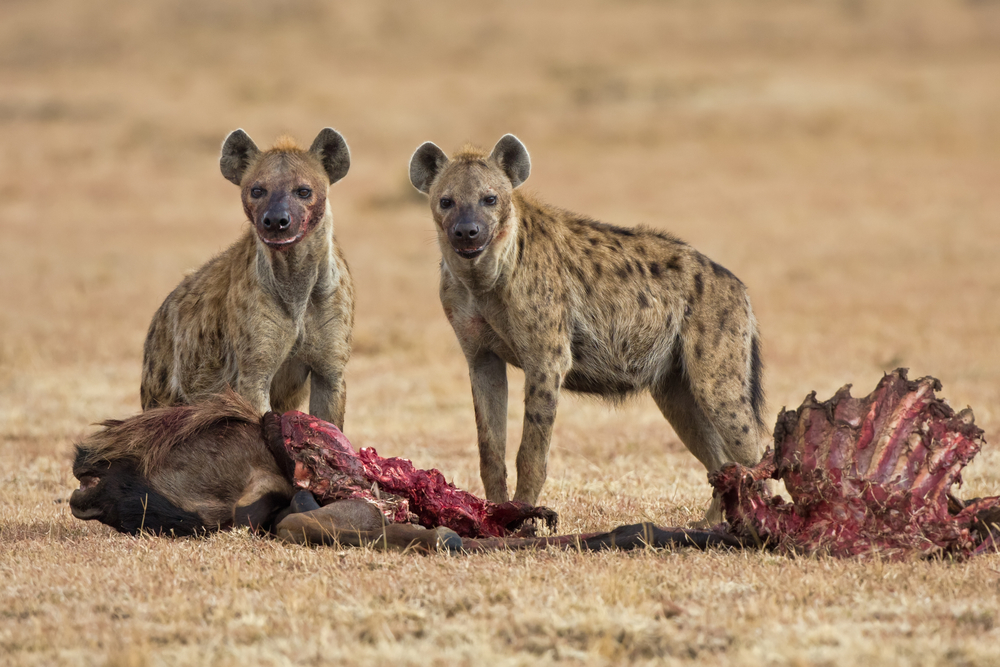
Males are typically thought of as the stronger sex, the provider and the protector, yet this is a view that is changing. For humans, the lack of female world leaders and inequality in certain aspects of life leads many to believe it very much remains a man’s world, at least for now. But for a surprising number of other animals, it is the female that is dominant over the male—here are just a few examples.
Bonobos

Bonobos, endemic to the Democratic Republic of Congo, live in communities consisting of males, females and their offspring, but which are female-dominated. Females obtain their rank as they age and have offspring, but a male can never be the alpha or highest ranking individual. This puzzled scientists, because males are bigger and stronger than females, but new research shows that female dominance has arisen in order to limit male aggression.
Researchers from the Max Planck Institute found that it is not alliances between females that win conflicts with males, it is actually related to female motivation to help offspring and their attractiveness. Whenever females are defending offspring from male aggression, males defer to females. In addition, females win conflicts more easily (and males are less aggressive) when they are displaying sexually ‘attractive’ qualities, such as sexual swellings. This indicates that it is the bonobo’s mating strategy that has shifted the dominance relationship between the sexes.
Octopus

Octopus are incredibly intelligent animals. They belong to a group of animals called cephalopods, with around 300 recorded species. They are molluscs, so related to oysters and limpets, but with the obvious difference of the octopus’ lack of a shell. They tend to be solitary animals, and profoundly antagonistic towards each other—they seem to view their own kind primarily as competition and sometimes even as food.
This is problematic for the male octopus, as he wants to mate and pass on his genes, however this involves getting close to the more dominant female. He has to insert his sperm directly into the female’s body using one of his arms but if he attempts this, the female—being larger and hungrier than he is—may instead strangle and eat him. Yet the male has a few tricks up his many sleeves, one of which involves sacrificing the entire mating arm to the female before making a hasty retreat. Alternatively, some sneak into the female’s den disguised as females themselves.
Honeybees

Honeybee colonies are dominated by females, one in particular. The queen bee is the mother of all who live in the hive and is vital to their survival. Larger than the other bees, she is the only female to possess a functioning set of ovaries and during summer months, produces up to 1500 eggs per day. The queen’s daughters—the workers—surround her and attend to her every need, feeding her, grooming her, and cleaning up after her.
They also govern the work of the colony, making tours of inspection and looking for anything that needs to be done to maintain it. On the other hand, the males—the drones—do not perform any maintenance task. Their role is simply to mate with the queen and produce the next generation. It may sound like they have it easy but don’t envy them too much. Unlike female honeybees, who have two copies of each chromosome like humans, males only have one set. Without another copy of each chromosome to mask any mutated genes, males are far more vulnerable to disease.
Killer Whales

Highly intelligent and highly social, killer whales live in complex matriarchal societies where females rule. Female killer whales are one of only a handful of animals on the planet to live many years after menopause. They stop reproducing at around 50 years old, which is the age when the males are reaching the end of their lives.
The females, however, have another 40 or so years to live, during which time they become group leaders thanks to their invaluable survival skills. Researchers studying resident killer whales in the Pacific Northwest observed post-menopausal female whales, the oldest in the group, typically swimming at the front of the group and directing its movements. Throughout their long lives, these females have gained wisdom on how and where to find food, knowledge that is in turn passed on to younger members of the group, boosting their survival and reproductive success.
Spotted Hyena

The brown hyena and the striped hyena both live in typical male-dominated societies, but the spotted hyena is different. All female spotted hyenas are dominant over males, even the lowest ranking female is dominant over the highest ranking male. Dominance is passed on from mother to daughter and granddaughter. So dominant are females that high-ranking adult males have been observed retreating from pubescent females and even tiny female cubs.
The reason behind female dominance in this particular species is thought to be related to their reproductive strategy. Spotted hyenas reproduce more slowly than other social carnivores, with no particular breeding season and females usually giving birth to two cubs every year or two, but one cub often dies. It is believed that spotted hyena societies were once male-dominated, with numbers limited by a meagre food supply. Once they started hunting co-operatively in order to kill larger animals, numbers grew thanks to the greater food availability.
But with more adults feeding at a kill, there was not enough food for the cubs and with only one cub every two years, this would lead to population decline. Tough females with higher levels of testosterone would have been better able to defend their cubs, were more successful at raising cubs, and therefore, the genes for high testosterone levels were passed on through the generations, resulting in the dominant females we see today.
